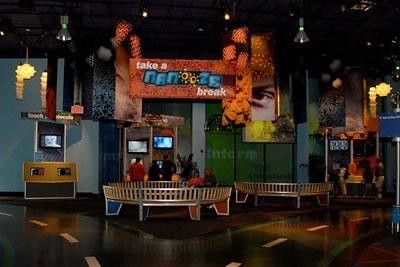This post is part of the Science Tuesday feature series on the USDA blog. Check back each week as we showcase stories and news from the USDA's rich science and research portfolio.
-----------------------------------------------------
A visit to the happiest place on earth now opens a window to some of the smallest things on earth.
A new long-term exhibit at Walt Disney World’s INNOVNTIONS at Epcot® opened last month to educate the public about nanotechnology and the science of the very small. Take a Nanooze Break features a number of interactive activities that allow visitors to explore common objects at the nanometer scale, manipulate models of molecules and interact with scientists and engineers who conduct the latest nanotechnology research.
The exhibit gives new meaning to the phrase “it’s a small world after all” using six dynamic videos produced by Cornell University researcher Carl Batt and funded by USDA’s National Institute of Food and Agriculture. The episodes, which were produced in collaboration with the international radio program EarthSky, cover both the potential benefits and risks of nanotechnology. As part of the grant to Batt, the public will be surveyed to gain an understanding of their opinions about nanotechnology and the information conveyed by the videos.
Nanotechnology is the science of studying and producing materials and devices of nanometer size--billionths of a meter, or about 10,000 times smaller than the width of a human hair. The emerging field of nanotechnology will no doubt lead to unprecedented understanding and control of the fundamental building blocks of all physical things. Potential applications are possible in plant and animal agricultural production, diagnostic devices to ensure food safety, food processing and manufacturing, human health and nutrition, biotechnology, medicine and drug delivery, information technology, homeland defense, energy production and efficiency, and environmental improvement.
Additional USDA funding into nanotechnology research has led to the development of a fabric that can detect biohazards such as E. coli, biosensors that can help detect diseases on farms and in hospitals, and to tracers that can uncover the sources of pollution in farm fields and waters.
The Epcot exhibit was based on the National Science Foundation-supported Nanooze children’s magazine and Web site designed to get kids excited about science and nanotechnology. With millions of people who visit Epcot each year, this work presents a great opportunity to share the latest advances in nanotechnology and how it can benefit our daily lives.

NIFA-funded videos are part of this exhibit, now being displayed at Epcot Center.
Credit: Cornell University Chronicle
Dr. Hongda Chen, National Program Leader for Bioprocessing Engineering and Nanotechnology at USDA’s National Institute of Food and Agriculture.
